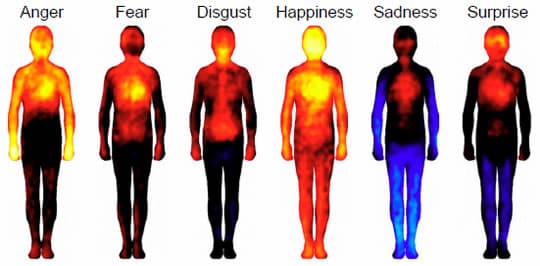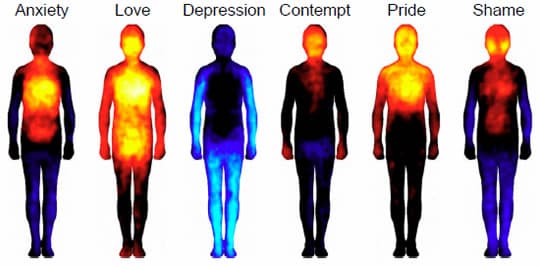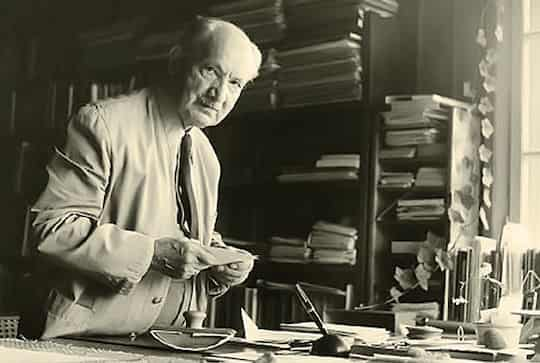Happiness is boosted by activities like thankfulness, spending on others, making plans, using signature strengths and happy daydreams.
Happiness is an emotion that activates the whole body.
Happiness literally fills the whole body with activity, including the legs, perhaps indicating that happy people feel ready to spring into action, or maybe do a jig (see: What Happiness Feels Like).
Happiness doesn’t just feel great, it also benefits the body, right down to its instructional code.
Happier people have a stronger expression of antibody and antiviral genes that are responsible for fighting off infectious diseases and defending the body against foreign materials.
Here are 18 activities, habits and ideas that science has proven can make you happier.
1. Mentally subtract something good from your life
People spend a lot of time thinking about good things that didn’t happen, but might have done.
But what about the good things that did happen that might not have?
Say you’d never met your partner or friend or got that job?
What would life be like without some of those things we take for granted?
Thinking about what might not have been can be tremendously powerful for happiness if used in the right way.
Counter-factual thinking can create meaning in life and, and can increase satisfaction with what you have (Koo et al., 2008).
So, mentally subtract something good from your life to really appreciate it.
2. Send a thankful message
Gratitude is a powerful emotion that helps us enjoy what we have.
Evoke it right now by sending an email, text or letter to someone who has helped you in some way.
Thank them for what they have done for you, however small.
It’s easy and quick and one study has found that practising gratitude can increase happiness 25%.
Another found that just three letters over a three-week period was enough to reliably increase happiness and life satisfaction (Toepfer et al., 2012).
3. Spend money on someone else
Money can make you happy but only if you use it in the right way.
One of the easiest ways is by spending it on others.
So, why does spending on others increase your happiness?
It’s partly because giving to others makes us feel good about ourselves.
It helps promote a view of ourselves as responsible and giving people, which in turn makes us feel happy.
It’s also partly because spending money on others helps cement our social relationships.
And, people with stronger social ties are generally happier.
So, buy a friend a present today or take them out to lunch.
You’ll feel good about it, I promise.
4. Get some exercise for more happiness
Exercise is the number one strategy that people use to feel better, increase their energy levels and reduce tension.
It doesn’t have to be a marathon; a simple walk around the block will do the trick.
We all know it’ll make us feel better to get out and stretch our legs, but there are always excuses to avoid it.
If you’re at home, make time for a trip that doesn’t involve the car and does involve your legs.
If you’re in the office, make sure you get out for a walk at lunch-time instead of eating sandwiches in front of the computer.
5. Music brings happiness
Number two on the list of the best happiness strategies is listening to music.
Music can influence mood in many ways but most people rate its power to manage our positive moods as the top reason they love music.
We particularly like the fact that it can make our good moods even better.
Even sad music can bring pleasure as many people enjoy the contradictory mix of emotions it creates.
6. Make plans for happiness
Remember those childhood days leading up to Christmas when you couldn’t wait to rip open your presents?
The pleasure in anticipation was just incredible.
Research on the psychology of happiness shows that anticipation can be a powerful positive emotion.
We enjoy looking forward to things much more than we enjoy looking back on them afterwards (Van Boven & Ashworth, 2007).
So, make a plan now and try to always have something to look forward to, however small.
It will make you feel more happiness
7. Happiness is making plans with friends
The best types of plans for happiness are with friends.
It’s not just that you’ll have the pleasure of anticipation; it’s also that you’re keeping the friendship alive.
One study of 8 million phone calls has found, not exactly surprisingly, that when people call each other back, their friendships are much more likely to survive (Hidalgo & Rogriguez-Sickert, 2007).
The power of friendship on happiness is much greater than money.
Researchers have calculated that you’d have to earn £85,000 ($130,000) more a year to make you as happy as if you saw friends or relatives on most days of the week (Powdthavee, 2008).
So, not only is staying in touch with friends good, but it’ll save you a lot of effort trying to earn more money at work.
8. List 3 good things that happened today
At the end of the day, before you go to bed, spend a few minutes thinking about three good things that happened today.
They don’t have to be that amazing; just three things that made you feel a little better.
You can also think about why they happened.
In one study in which people carried out this exercise, their happiness was increased, and depressive symptoms decreased, fully six months afterwards (Seligman et al., 2005).
If you’ve done some of the things mentioned here, then you’ll already have at least three things for your list.
9. Signature strengths help increase happiness
Simply put signature strengths are things you are good at.
Whatever it is, people usually feel more happiness when they do things at which they excel.
Think about things that you are good at: it could be social skills, physical skills, sporting skills or anything really.
It could be making someone laugh or giving someone a helping hand.
Then take some time during the day to use that skill.
When people practice their signature strengths it makes them happier.
10. Enjoy a happy daydream activity
If you’re less of a doer and more of a dreamer, then this activity is for you: have a happy daydream.
Over the course of the day our minds tend to wander a lot, but directing that mind-wandering in a positive way can be very beneficial.
In this research on life-savouring strategies, positive mental time travel was found to be one of the most effective.
In the study people thought back to times in their lives that gave them pleasure; moments filled with success, love and friendship.
The mind may try to fight back by travelling back to past embarrassments or failures, but keep it locked into a happy daydream for the best boost.
Go on, sit back and have a little daydream…
11. Pull together for happiness
What has happened to people’s happiness all around the world as they’ve faced recent crises?
How have they coped with job losses, less money coming in, the sense of despair and lack of control over a nightmare that seems to have no end?
One answer is: some have pulled together.
Data from 255 metropolitan areas across the US found that communities that pull together — essentially doing nice little things for each other like volunteering and helping a neighbour out — are happier.
Social capital has a protective effect: people are happier when they do the right thing.
12. Act like an extrovert
Acting like an extrovert — even if you are an introvert — makes people all around the world feel more happiness (Ching et al., 2014).
The findings come from surveys of hundreds of people in the US, Venezuela, the Philippines, China and Japan.
Across the board, people reported that they felt more positive emotions in daily situations where they either acted or felt more extroverted.
Participants in the study were told to act in an outgoing way for 10 minutes and then report how it made them feel.
Even amongst introverts — people who typically prefer solitary activities — acting in an extroverted way gave them a boost of happiness.
13. Enjoy ordinary activities
With increasing age, people get more pleasure out of everyday activities.
A recent study asked over 200 people between the ages of 19 and 79 about happy activities they’d had that were both ordinary and extraordinary.
Across all the age-groups in the study, people found pleasure in all sorts of activities; both ordinary and extraordinary.
But it was older people who managed to extract more happiness from relatively ordinary activities.
They were happier spending time with their family, from the look on someone’s face or a walk in the park.
Younger people, meanwhile, defined themselves more by extraordinary activities.
14. Become less materialistic
The reason that materialistic people are less happy is that a focus on what you want — and therefore don’t currently have — makes it more difficult to appreciate what you already have.
A study found that materialists also feel less gratitude which, in turn, is associated with lower levels of life satisfaction.
The study quotes the words of Greek philosopher Epicurus, who said:
“Do not spoil what you have by desiring what you have not; remember that what you now have was once among the things you only hoped for.”
By law, all credit cards should have this quote across the front in fluorescent pink.
15. Work on your relationships
Relationships have stronger associations with happiness than academic achievement, according to research.
Whilst strong social relationships in childhood and adolescence are associated with happier adults, the associations with academic achievement were much lower.
It seems that all the education in the world won’t necessarily teach you much about what it means to be happy, in either the emotional or philosophical sense.
Stronger relationships, though, tend to boost happiness.
16. Make concrete goals for happiness
Surprisingly, people are often wrong about the type of goals that will make them happiest.
Research finds that certain concrete goals for happiness work better than abstract goals.
The study found that acts performed in the service of a concrete goal (making someone smile) made the givers themselves feel more happiness than an abstract goal (making someone happy).
By thinking in concrete ways about our goals for happiness, we can minimise the gap between our expectations and what is actually possible.
17. Happiness from mundane moments
Mundane, everyday experiences can provide unexpected joy down the line, new psychological research finds.
In one study, 135 students were asked to create a time capsule at the start of the summer which included:
- a recent conversation,
- the last social event they’d attended,
- an extract from a paper they’d written,
- and three favourite songs.
At the time, they also predicted how they’d feel about these items when they opened the capsule three months later.
Despite being relatively mundane, the students significantly under-estimated how surprised and curious they would be when they opened it.
The study is a reminder of how we tend to undervalue the happiness we can get from everyday events.
So, why not make a little time capsule today?
18. The six domains of happiness
One theory, put forward by Professor Carol Ryff, suggests there are six domains of human growth important to happiness:
- self-acceptance,
- the establishment of quality ties to other,
- a sense of autonomy in thought and action,
- the ability to manage complex environments to suit personal needs and values,
- the pursuit of meaningful goals and a sense of purpose in life,
- continued growth and development as a person.
Pay attention to these six domains of happiness — particularly where there is a lack — and do what you can to address them.
.













